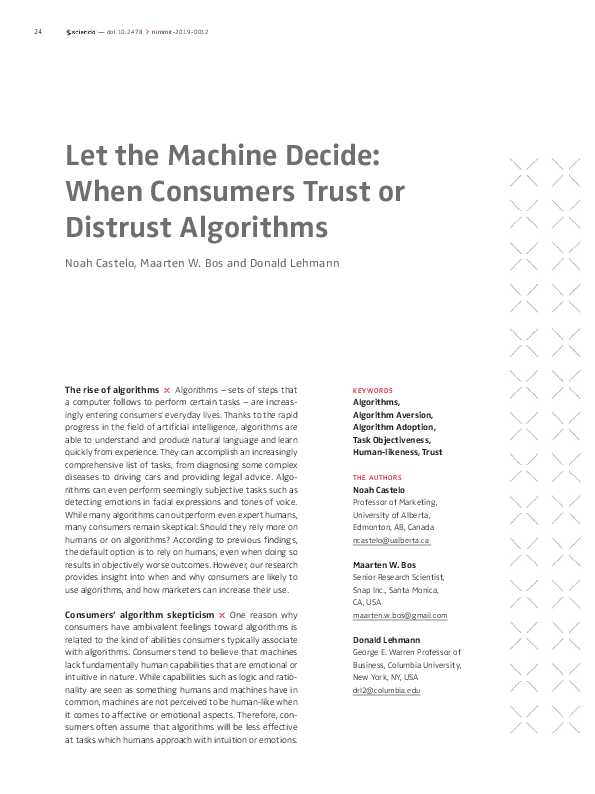Let the Machine Decide: When Consumers Trust or Distrust Algorithms
Noah Castelo, Maarten W. Bos and Donald Lehmann
Thanks to the rapid progress in the field of artificial intelligence, algorithms are able to accomplish an increasingly comprehensive list of tasks, and often they achieve better results than human experts. Nevertheless, many consumers have ambivalent feelings towards algorithms and tend to trust humans more than they trust machines. Especially when tasks are perceived as subjective, consumers often assume that algorithms will be less effective, even if this belief is getting more and more inaccurate.
To encourage algorithm adoption, managers should provide empirical evidence of the algorithm’s superior performance relative to humans. Given that consumers trust in the cognitive capabilities of algorithms, another way to increase trust is to demonstrate that these capabilities are relevant for the task in question. Further, explaining that algorithms can detect and understand human emotions can enhance adoption of algorithms for subjective tasks.

![[Translate to English:] [Translate to English:]](/fileadmin/_processed_/e/e/csm_hildebrand_intro_ai_vol_11_no_2_de_1e0479d1e9.png)
![[Translate to English:] [Translate to English:]](/fileadmin/_processed_/3/7/csm_2019_nim_mir_ai_de_res__Kapitel_1__2fa844ec2e.png)
![[Translate to English:] [Translate to English:]](/fileadmin/_processed_/2/e/csm_2019_nim_mir_ai_de_res__Kapitel_3__b6b9b04ed2.png)
![[Translate to English:] [Translate to English:]](/fileadmin/_processed_/4/d/csm_2019_nim_mir_ai_de_res__Kapitel_4__c125a66154.png)
![[Translate to English:] [Translate to English:]](/fileadmin/_processed_/d/5/csm_2019_nim_mir_ai_de_res__Kapitel_5__5621369382.png)
![[Translate to English:] [Translate to English:]](/fileadmin/_processed_/8/4/csm_taylor_ai_vol_11_no_2_eng_6d2c64d841.png)
![[Translate to English:] [Translate to English:]](/fileadmin/_processed_/c/2/csm_2019_nim_mir_ai_de_res__Kapitel_6__ce9e09e186.png)


